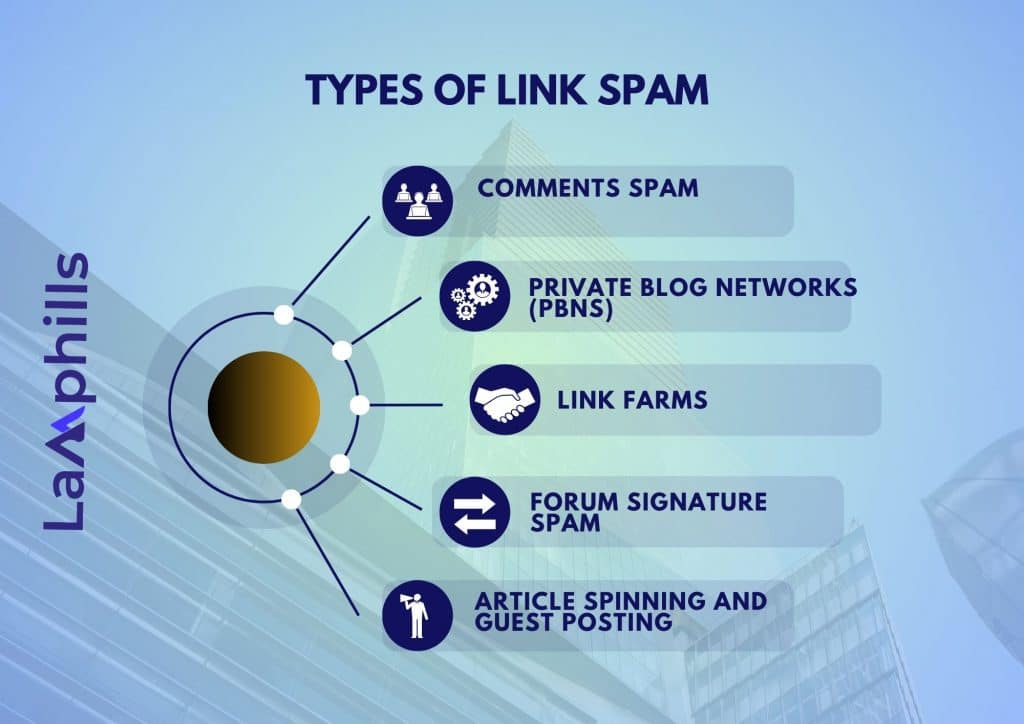Link spam is an SEO issue that affects users, website owners, and search engines. Even though search engines like Google have upped their game in identifying and dealing with spam links, the people who take advantage of black-hat SEO practices keep upping their game. These new tricks will always be discovered, but users and website owners must protect themselves from link spam. The best solution remains to understand how link spam works, know the various types and how to identify them, and implement countermeasures. My website’s domain authority was once affected by this, and trust me, you wouldn’t want to be a victim. I don’t want you to be a victim as an online user or a website owner. Together, we can all mitigate the impact of link spam and maintain the integrity of online content.
Key Points
- Link spam, or spamdexing, is a deceptive tactic used to manipulate search engine rankings by artificially inflating the number of inbound links to a website.
- It affects users, website owners, and search engines.
- The best way to deal with it is to understand how link spam works, know the various types and how to identify them, and implement countermeasures.
- The primary idea behind link spam is to exploit the importance search engines place on backlinks as indicators of a website’s authority and relevance.
- To remove spam links from your website, first identify and evaluate them as spam links.
Understanding Link Spam
Link spam, or spamdexing, is a deceptive tactic used to manipulate search engine rankings by artificially inflating the number of inbound links to a website. These tactics can distort search engine results, degrade the user experience, and harm the credibility of legitimate websites. The idea behind it is generally to get people to click through links they originally wouldn’t dare to click, and in so doing, they boost their ranking. Search engines like Google heavily rely on high-quality backlinks to rank your content for specific keywords. Unfortunately, it requires hard work, and people who are unwilling to put in the work resolve to spam links.
What is Link Spam?
Link spam involves creating links in a way that is intended to game search engine algorithms. Let’s break things down a little, Search engines like Google use links as a major factor in determining the relevance and authority of a webpage. The more high-quality links pointing to a site, the higher it is likely to rank. This is about credibility and takes time and effort to yield results. Spammers exploit this by generating several low-quality or irrelevant links to boost their site’s visibility.
What is the Idea Behind Link Spam?
The primary idea behind link spam is to exploit the importance search engines place on backlinks as indicators of a website’s authority and relevance. Rather than do the hard work of genuinely building credibility, spammers create a large number of low-quality or irrelevant links pointing to their websites to artificially boost their search engine rankings.
Generally, search engines like Google use backlinks as one of the key factors in their algorithms to rank websites. Backlinks are essentially votes of confidence from one site to another. When a reputable site links to your content, it signals to search engines that your site is trustworthy and relevant. The more high-quality backlinks a site has, the higher it is likely to rank in search engine results.
Read Also: How You Can Secure High-Quality Relevant Links to Improve Your SEO Rankings
Types of Link Spam

The following are some of the popular link spam that scammers use to date:
#1. Comment Spam
This happens when a spammer posts irrelevant comments on blogs or forums that include links to their website. While this may not be the most cunny of spammy links, I have my reason for making it top on the list. I’m a digital marketer who also blogs about topics relating to my field, and I’ve lost count of the number of times comments not related to issues I was trying to address were made on my posts with links attached to them. Thanks to WordPress, I now control my comments through the approval features on the backend. Initially, dealing with this type of link spam was annoying, but since I discovered that feature, I no longer care because they remain unapproved at the backend.
#2. Private Blog Networks (PBNs)
A Private Blog Network (PBN) is a collection of blogs owned by the same person or group, intending to build backlinks to a central website to boost its search engine rankings. PBNs are considered a black-hat SEO technique because they violate Google’s Webmaster guidelines. They are generally multiple blogs with similar themes but different domains, all linking to a single site.
PBN operators acquire expired or auctioned domains with existing backlinks and authority. These domains have a level of established trust and authority from previous content and links. The acquired domains are used to set up new websites, and content is created for each PBN site, revolving around different topics to maintain the appearance of diversity. Unfortunately, each PBN site includes backlinks to the central (target) website that the operator wants to rank higher in search engine results.
How Do I Avoid Private Blog Networks (PBNs)?
Using PBNs can lead to severe penalties from search engines, including ranking drops and deindexing. As a result, I guard against this because my website’s health depends on it. There are several ways of avoiding PBNs, below are some of the tactics I adopt:
- Regularly audit your backlink profile
- Avoid buying links
- Focus on high-quality content and outreach
- Set up Google Alerts
- Use the Disavow tool for unwanted links
#3. Link Farms
A link farm is a network of websites created specifically to link to each other. The goal is to artificially inflate the number of inbound links to a particular site or set of sites. Like other types of spam links, the aim is to manipulate rankings by exploiting the importance placed on backlinks.
During a research project, I stumbled upon a network of websites that seemed to have no other purpose than linking to each other. Oftentimes, these websites are easy to recognize because their contents are shallow, and the interlinking pattern is obvious and unnatural.
How Do I Avoid Link Farms?
To avoid link farms, I regularly audit my backlink profile, create high-quality content, and engage in legitimate outreach. If you can add this to the list of general tips in the later part of this guide, you’ll safeguard your website against link farms.
#4. Forum Signature Spam
Forum signature spam is a tactic used by spammers to create backlinks to their websites by embedding links in their forum signatures.
How Does this Work?
Spammers who use this tactic create accounts on multiple forums. Of course, they choose websites with high traffic or high domain authority. Generally, a forum account includes a signature section. This is a block of text that appears below every post the user makes. These guys embed links to their websites in these signature sections, often with anchor text targeting specific keywords. This means that in any discussion the spammer engages in, their signature appears frequently. In simple terms, the signature is a backlink to their site.
I’m an active participant in a digital marketing forum, where thoughts, trends, and ideas are shared on related topics. Recently, I noticed a new user whose every post, regardless of the topic, includes a signature linking to a dubious e-commerce site. This not only disrupted discussions but also undermined the forum’s credibility.
How Do I Avoid Forum Signature Spam?
To avoid forum signature spam, I do the following:
- I ignored the tempting idea of using this and focused on building links naturally.
- My contents are both valuable and engaging
- I use signatures responsibly
- Follow forum guidelines
- Diversify link-building strategy
- You can monitor and clean up forum signature spam if you have a forum.
#5. Article Spinning and Guest Posting
Article spinning is rewriting existing content multiple times to create numerous unique versions. This is done to avoid duplicate content penalties and to generate a large volume of articles that can be used to build backlinks. On the other hand, guest posting involves writing and publishing an article on someone else’s blog or website. When done correctly, it is a legitimate and valuable SEO strategy that benefits both the guest poster and the host site.
Article spinning and guest posting occur when spammers rewrite existing articles multiple times (spinning) and submit them as guest posts across various blogs, each time embedding links to their website. As a blog owner, I received several guest post submissions that, upon closer inspection, had nearly identical content but came from different authors. Each post included links to the same few websites, indicating an attempt to manipulate search rankings.
How Do I Avoid Article Spinning and Guest Posting?
To avoid article spinning and guest posting, I simply focus on creating original, valuable content and following best practices for guest posting. Add these to the other relevant tips in this guide, and you’ll build a strong, credible online presence.
Other Types of Link Spam
- Press release links
- Automated Link Building
- Low-Quality Directories
- Link Exchanges
- Paid Links
- Sitewide links
- Hidden links
Read Also: How You Can Secure High-Quality Relevant Links to Improve Your SEO Rankings
What’s the Impact of Link Spam?
While the primary reason behind link spam is to cheat search engine algorithms and benefit the website owner, it harms website owners, search engines, and end users.
- Users: Link spam degrades the user experience by filling valuable content spaces with irrelevant or low-quality links.
- Website Owners: Genuine website owners suffer as their sites are flooded with spam comments or links. Unfortunately, this can lead to a decrease in user engagement and credibility.
- Search Engines: Link spam complicates the task of delivering relevant search results, undermining the trustworthiness of the search engine.
General Tips On How to Avoid or Combat Link Spam
As mentioned, link spam hurts users, website owners, and search engines. On the part of the website, the effect may be worse because you may likely lose your site’s relevance and SEO ranking. Website owners must therefore devise ways of combating and avoiding link spam. The following are some of the tips I use to avoid or combat link spam:
#1. Audits
Learn to audit your website’s backlinks periodically because it’ll help you identify and disavow spammy links. To do this, use tools like Google Search Console and Ahrefs to monitor your site’s backlink profile. Once you identify any suspicious or low-quality links, use Google’s Disavow Tool to prevent them from affecting your site’s SEO.
#2. Moderation Tools
Moderation tools are another tactic I use to combat or avoid link spam. It’s 100% effective against comment spam. All I had to do was integrate the CAPTCHA system and use spam filters for comments and forum posts.
If you want similar result, you can integrate CAPTCHA into your blog’s comment section and use advanced spam filters to automatically detect and block suspicious content. This reduces the manual effort required to manage spam.
#3. No-Follow Links
My brand’s website was built with WordPress, and I take advantage of the no-follow link feature. Marking user-generated content links with the nofollow attribute prevents search engines from following these links.
If you’re a forum administrator, apply the nofollow attribute to all user-generated content. This ensures that search engines do not pass link equity from these links. It’ll also discourage spammers from targeting your site.
How Do I Identify Spam Links?
To identify spam links, you’ll have to do the following:
- Analyze the Domain Authority (DA) and Page Authority (PA)
- Evaluate content quality
- Check the link profile
- Examine the anchor text
- Check for sudden spike in links
- Review the linking page
- Analyze the site’s reputation
- Review the linking domain’s link neighborhood
- Analyze IP address diversity
How Do I Remove Spam Links From My Website?
To remove spam links from your website, you must identify and evaluate them before removing them. You can do this by contacting webmasters, using Google’s Disavow Tool, and regularly monitoring your backlink profile. The following is a detailed guide that has worked for me over time, and I trust it’ll help you too:
#1. Identify Spam Links
The first step to removing spam links from your website is identifying the links as spam. If you’re wondering how to do this, relax; tools and techniques are available. You can use Google Search Console, SEO tools, or manually review your backlinks.
Google Search Console (GSC) is a free tool provided by Google that helps webmasters, SEO professionals, and site owners monitor, maintain, and troubleshoot their site’s presence in Google Search results. It offers a range of features that can provide valuable insights into how Google views your website and how it performs in search results. It analyzes your site’s backlink profile, including total links, linking sites, and anchor text distribution. All you have to do is go to the “Links” section to view who links to your site. Afterward, check for unusual or suspicious links from low-quality sites.
You can also use SEO tools like Ahrefs, SEMrush, and Moz to analyze your backlink profile. These tools provide detailed reports on your backlinks, including domain authority, anchor text, and link quality. Lastly, manually inspect the linking sites to identify low-quality, irrelevant, or suspicious links.
#2. Evaluate the Links
In terms of evaluating, you can determine which links are spammy by looking out for the following characteristics:
- Low Domain Authority: Links from websites with very low domain authority (DA) are often spammy. Use tools like Moz to check DA.
- Irrelevant Content: Links from sites that are unrelated to your niche or content are suspicious.
- Over-Optimized Anchor Text: Repeated use of exact match keywords in anchor text is a common spam tactic.
- Link Farms and PBNs: Websites with unnatural interlinking patterns or those that look like part of a network (Private Blog Networks) created solely for linking purposes.
#3. Contact Webmasters
Once you’ve identified and verified that a link is spam, you can request removal by contacting webmasters through the following steps:
- Look for the Contact Information: Look for contact details on the linking site, such as an email address or contact form. You can also use WHOIS lookup tools if contact details are unavailable.
- Draft a Request Email: When drafting an email for this, be polite and clear in your email. Explain that the link harms your site’s SEO and request removal.
#4. Use Google’s Disavow Tool
If webmasters do not respond or refuse to remove the links, use Google’s Disavow Tool to disavow the spammy links. This tells Google to ignore these links when evaluating your site. You can use the steps below to achieve this:
- Create a Disavow File: List the URLs or domains you want to disavow in a text file (.txt format). Make sure each line contains a single URL or domain.
- Upload the Disavow File: To do this, go to Google Search Console and select your property. Navigate to the Disavow Tool page, upload your disavow file, and submit it.
#5. Regularly Monitor Your Backlink Profile
Regular monitoring helps in the early detection of new spam links. While it might be time-consuming, you don’t want the penalty that comes with such links to affect your site. Therefore, pay the price to maintain a healthy backlink. To seamlessly monitor your backlink profile, you can do the following:
- Use Google Search Console to set up email alerts for new links.
- Use SEO tools like Ahrefs, SEMrush, or Moz to monitor your backlinks and receive notifications about new links.
Lamphills’ Webmaster Email Link Removal Template
Download Laphiills Webmaster Email Link Removal Template
How Do You Check if a Link is Spam or Not?
The following is how I check if a link is spam on my website:
- Use tools to analyze domain authority (DA) and page authority (PA): Links from websites with fluctuating domain authority, and very low domain or page authority are often spammy.
- Evaluate the Content Quality: Here, I look out for irrelevant content, thin content, or duplicate content. You can use Copyscape, or Grammarly to evaluate this.
- Check the Link Profile: Here, I look out for link farms, private blog networks, or excessive reciprocal links. These are all spam links.
- Examine the Anchor Text: Here, I look out for over-optimized and irrelevant anchor text:
- Check for Sudden Spike in Links: Here, I look out for unnatural growth and irregular patterns.
- Review the Linking Page: Here, I look out for three things: poor user experience, hidden links, and irrelevant pages. Hidden links are mostly embedded in small text, hidden in the footer, or with a font color matching the background. A poor user experience is evident once the pages are filled with ads, pop-ups, and low-quality user interfaces. Irrelevant page links are placed on pages with no thematic relevance to your site.
- Analyze Site Reputation: Here, I do a backlink check by verifying if the linking site is listed on any spam or malware blacklists. I also check reviews and user feedback about the site because sometimes, someone might have uncovered the link before me
- Analyze IP Address Diversity: Here, I guard against the same IP addresses. These are links coming from multiple domains hosted on the same IP address.
Best Practices for a Healthy Backlink Profile
If you want a healthy backlink profile, you can consider the following activities:
- Create High-Quality Content: When your website is filled with high-quality content, you’ll naturally attract natural backlinks.
- Guest Posting: Write guest posts for reputable sites in your niche to earn high-quality backlinks. However, ensure that the contents are original and valuable too.
- Building Relationships: Network with other bloggers and site owners to earn legitimate backlinks.
Related Articles
- 15 Best Link Building Tools: A Comprehensive Review from My Personal Experience
- Link Building Outreach: Beginners Guide (+Templates)
- Content Syndication: A Comprehensive Guide






